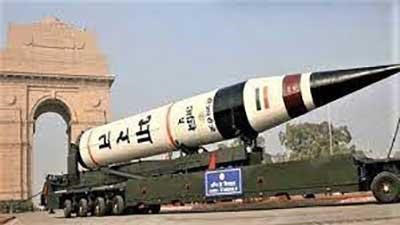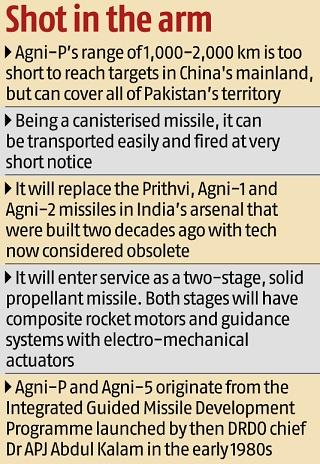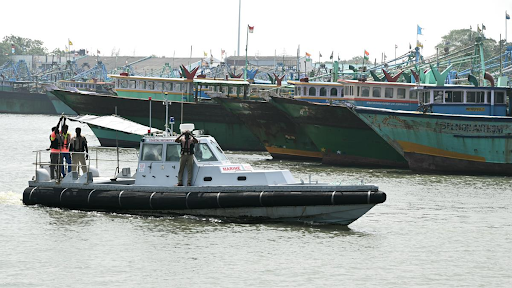Description

Disclaimer: Copyright infringement not intended.
Context
- Strategic Forces Command (SFC), along with the Defence Research and Development Organisation (DRDO), conducted the successful flight test of New Generation Ballistic Missile Agni-Prime from Dr APJ Abdul Kalam Island off the coast of Odisha.
Details
- The 'Agni Prime' or 'Agni-P' is a nuclear-capable new-generation advanced variant of the Agni class of missiles.
- It is a surface-to-surface, canister-launched, road-mobile, and solid-fueled medium-range ballistic missile.
- It is a two-stage canistered missile with a maximum range of 1,000 to 2,000 km.
- The 'Agni Prime' missile is lighter than all the earlier Agni series of missiles.
- It is the sixth missile in the Agni series.

Agni missile
- The Agni missile is a family of medium to intercontinental-range ballistic missiles developed by India, named after one of the five elements of nature. Agni missiles are long-range, nuclear weapons capable, surface-to-surface ballistic missiles.
- The first missile of the series, Agni-I was developed under the Integrated Guided Missile Development Programme (lGMDP) and tested in 1989.
Agni Variants
Agni-1:
- The nuclear-capable road-mobile missile was first deployed by the Indian Army's Strategic Forces Command in 2007.
- It is a single-stage, solid-fuel missile.
- It is a short-range ballistic missile (SRBM) with a heavy payload but can travel up to 1200 km with lighter payloads, which makes it a medium-range ballistic missile (MRBM).
- Range: 700 km- 1200 km
- Powered by a solid-propellant booster based on the Indian Space Research Organisation's (ISRO) SLV-3.
- The Agni-I is designed to be launched from rail-based platforms or road-mobile transporter erector launchers (TELs)
Agni II:
- It was developed by Advanced Systems Laboratory, along with other DRDO laboratories and integrated by Bharat Dynamics Limited.
- It is a surface-to-surface medium-range nuclear-capable missile.
- Range: 2000 km (can be increased to 3000 km by reducing the payload).
- It is a two-stage ballistic missile with solid fuel.
- Payload: 1000 kg.
Agni III
- The Agni-III is a two-stage, solid-propellant missile deployed in rail-mobile mode.
- It is an Intermediate Range Ballistic Missile.
- Surface-to-surface ballistic missile.
- Range: 3,500 km
- Payload: 1500 kg

Agni IV:
- Agni-4 is an intermediate-range ballistic missile
- Payload: 1,000 kg
- Range: Up to 4,000 km.
- It is a surface-to-surface missile.
- It is a mobile, two-stage solid-fuel system.
- Equipped with state-of-the-art Avionics, the 5th generation onboard computer, and distributed architecture.
Agni-V:
- Agni-V is an intercontinental ballistic missile (ICBM) powered by solid fuel.
- Nuclear-capable missile, which uses a three-stage solid-fuelled engine.
- It's an advanced surface-to-surface ballistic missile.
- It is a three-stage solid-rocket-powered missile capable of carrying a 1.5-tonne nuclear warhead.
- Range: 5,000 to 5,500 kilometers.
- Which puts major cities in China, including the capital Beijing, within its range.
It is the longest missile in the Agni series, with a range of nearly 5,000 kilometers. With this range, India can target Beijing, the capital of China.
|
PYQs on Agni Missile
Q. With reference to Agni-IV Missile, which of the following statement(s) is/are correct? (UPSC Prelims 2014)
- It is a surface-to-surface missile.
- It is fuelled by liquid propellant only.
- It can deliver a one-tonne nuclear warhead about 7500 km away.
Select the correct answer using the codes given below.
- 1 only
- 2 and 3 only
- 1 and 3 only
- 1, 2 and 3
Answer: 1
PRACTICE QUESTION
Q. Consider the following statements about Agni Prime (Agni-P):
1. It is a three-stage canisterised missile.
2. It is the newest and sixth variant of the Agni series missiles under IGMDP - Integrated Guided Missile Development Program.
3. The 'Agni Prime' missile is lighter than all the earlier Agni series of missiles.
How many of the statements given above is/are correct?
A. Only One
B. Only Two
C. All Three
D. None
Answer- B
|











